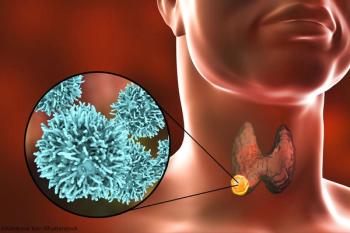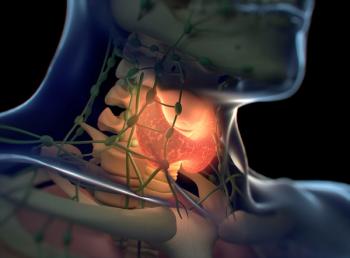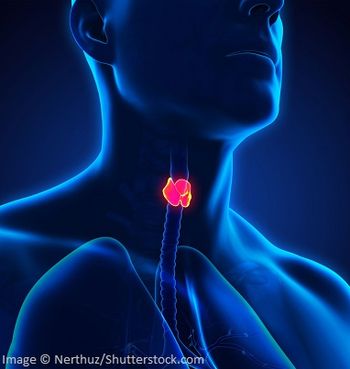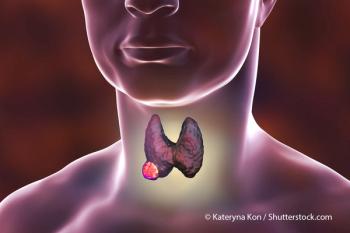
- ONCOLOGY Vol 11 No 8
- Volume 11
- Issue 8
Thyroid Cancer Surgical Practice Guidelines
The Society of Surgical Oncology surgical practice guidelines focus on the signs and symptoms of primary cancer, timely evaluation of the symptomatic patient, appropriate preoperative evaluation for extent of disease, and role of the surgeon in
The Society of Surgical Oncology surgical practice guidelines focuson the signs and symptoms of primary cancer, timely evaluation of the symptomaticpatient, appropriate preoperative evaluation for extent of disease, androle of the surgeon in diagnosis and treatment. Separate sections on adjuvanttherapy, follow-up programs, or management of recurrent cancer have beenintentionally omitted. Where appropriate, perioperative adjuvant combined-modalitytherapy is discussed under surgical management. Each guideline is presentedin minimal outline form as a delineation of therapeutic options.
Since the development of treatment protocols was not the specific aimof the Society, the extensive development cycle necessary to produce evidence-basedpractice guidelines did not apply. We used the broad clinical experienceresiding in the membership of the Society, under the direction of AlfredM. Cohen, MD, Chief, Colorectal Service, Memorial Sloan-Kettering CancerCenter, to produce guidelines that were not likely to result in significantcontroversy.
Following each guideline is a brief narrative highlighting and expandingon selected sections of the guideline document, with a few relevant references.The current staging system for the site and approximate 5-year survivaldata are also included.
The Society does not suggest that these guidelines replace good medicaljudgment. That always comes first. We do believe that the family physician,as well as the health maintenance organization director, will appreciatethe provision of these guidelines as a reference for better patient care.
Symptoms and Signs Early-stage disease
- Asymptomatic
- Mass in the thyroid region
- Presence of enlarged lymph node in the supraclavicular region
- Vague pain or discomfort in the thyroid region
Advanced-stage disease
- Cervical lymphadenopathy
- Large mass in the thyroid region
- Rapidly increasing thyroid nodule
- Change in voice
- Difficulty in breathing
- Difficulty in swallowing
Evaluation of the Symptomatic Patient Work-up
- Clinical evaluation, physical examination, complete head and neck examination,including indirect laryngoscopy
- Risk factor analysis
- Fine-needle aspiration (FNA)
- Ancillary diagnostic work-up if necessary
- Thyroid function tests
- Ultrasound, thyroid scan, and CT scan in selected patients
Appropriate timeliness of surgical referral
- Initial work-up should include a thorough and detailed clinical examinationand evaluation of the physical findings.
- FNA should be considered the first diagnostic test.
- Evaluation of a solitary thyroid nodule
- If FNA is benign, begin levothyroxine for 3 to 6 months.
- If lesion regresses or is unchanged, follow clinically.
- If lesion increases in size, operate.
- If FNA shows follicular neoplastic cells, obtain a thyroid scan.
- If scan reveals a "cold" nodule, operate.
- If scan reveals a "hot" nodule, observe.
- If FNA shows malignant or suspicious cells, operate.
Preoperative Evaluation for Extent of Disease Physical examination Indirect laryngoscopy Chest x-ray Baseline thyroglobulin for papillary cancer and calcitoninfor medullary cancer
Role of the Surgeon in Initial Management Evaluation of the symptomatic patient
- Clinical examination
- Indirect laryngoscopy with fiberoptic laryngoscope if necessary
- FNA of the neck or thyroid mass
- Chest x-ray for evaluation of the airway
Diagnostic procedures
- FNA
Surgical considerations: well-differentiated (papillary and follicular)thyroid cancer
- Risk group analysis is very helpful.
- Age
- Grade
- Extracapsular extent of disease and tumor Size (AGES)
- Presence of distant Metastasis
- Extracapsular spread of disease and tumor Size (AMES)
- Surgical procedures
- Lobectomy and isthmectomy
- Subtotal thyroidectomy
- Near total thyroidectomy
- Total thyroidectomy
- Modified neck dissection in selected patients
Surgical considerations: medullary carcinoma of the thyroid
- Total thyroidectomy with appropriate neck dissection should be performedif nodes are clinically palpable.
- Central compartment clearance is extremely important.
Surgical considerations: anaplastic thyroid cancer
- Diagnosis can be made based on clinical suspicion of a rapidly growingmass, age of the patient, unusual symptoms, a rapidly growing mass in thecentral compartment of the neck and fixed to the surrounding structures,and airway problems.
- FNA will raise suspicion of anaplastic thyroid cancer.
- Confirmation of the diagnosis can be made by either open biopsy orTru-cut needle biopsy (core biopsy).
- Treatment should consists of the combination of chemotherapy (includingdoxorubicin) and external radiation therapy.
- The role of surgery is very limited.
- Occasional patients may need a tracheostomy. (Most of these patientswill do very poorly.)
These guidelines are copyrighted by the Society of Surgical Oncology(SSO). All rights reserved. These guidelines may not be reproduced in anyform without the express written permission of SSO. Requests for reprintsshould be sent to: James R. Slawny, Executive Director, Society of SurgicalOncology, 85 West Algonquin Road, Arlington Heights, IL 60005.
Although thyroid cancer is not of the more common tumors, it accountsfor 90 % of tumors originating in the endocrine glands. Approximately 16,000patients with thyroid cancer are seen every year, and 1,200 patients diefrom this cancer annually.
The most important risk factor for thyroid cancer is a history of radiationto the neck. The most common indications for neck irradiation include acneand other skin conditions and an enlarged tonsil or thymus. The incidenceof thyroid cancer is slightly higher in patients with Graves' disease andthyroiditis.
There are four main types of thyroid cancer: papillary, follicular,medullary, and anaplastic. The differentiated thyroid cancers (papillaryand follicular) account for less than 90% of all thyroid malignancies,while medullary and anaplastic represent 5% to 10% and greater than 5%of cases, respectively. Hurthle cell cancers were formerly includedin the differentiated group, but the World Health Organization has eliminatedHurthle cell tumor as a separate category and included it as a variantof follicular thyroid cancer.
Papillary cancer is more common in younger individuals (those in thesecond and third decades of life), while anaplastic thyroid cancer is uniformlyseen in the sixth and seventh decades. Follicular cancer is more commonin endemic regions, such as Europe. The majority (approximately 80%) ofpatients with medullary cancer have a sporadic form of the disease, andthe remaining 20% have familial disease.
The most common presentation is an asymptomatic mass in the thyroidregion. Occasional patients, particularly those 20 to 35 years old or thoseover age 60, may present with enlarged supraclavicular lymph nodes.Patients with advanced-stage disease may present with massive cervicallymphadenopathy, a large, fixed mass in the thyroid region, or a changein voice. Occasionally, the patient may exhibit difficulty in breathingor swallowing on presentation.
The evaluation of the symptomatic patient with a suspected thyroid malignancyconsists of a clinical history, physical examination, and complete headand neck examination, including indirect laryngoscopy. The ancillary diagnosticwork-up includes an ultrasonogram, a CT scan, thyroid function tests, andfine-needle aspiration (FNA). If the FNA report is definitely benign andthere is no clinical suspicion of malignancy, the patient may be treatedwith suppressive therapy and followed for 3 to 6 months.
Preoperative evaluation includes physical examination, indirect laryngoscopy,chest x-ray, and thyroid function tests.
The current American Joint Committee on Cancer staging for thyroid canceris shown in Table 1, along with approximate5-year survival rates by stage. The staging system for thyroid cancer isquite different from the systems for other tumors in the head and neck.The T1 tumor is described as less than 1 cm in greatest dimension, whilethe T4 tumor indicates extrathyroidal disease extension. The presence oflymph node metastasis is described as N1 disease; there is no further stagingof nodal status.
Separate stage groupings are recommended for differentiated, medullary,and undifferentiated thyroid cancers. Age is an important prognostic factorin differentiated thyroid cancer, and this is the only cancer in whichage is used in stage grouping. Patients below the age of 45 with differentiatedthyroid cancer as considered to have stage I or II disease. Stage III andIV tumors relate to patients above age 45. Lymph node metastasis has verylittle prognostic bearing, and, in younger individuals, even those withdistant metastasis, the survival outcome is quite satisfactory. The anaplasticthyroid cancers are always considered to be stage IV, with an extremelypoor prognosis overall.
Survival is excellent in patients with papillary cancer, exceeding 95%,and is slightly lower in those with follicular cancer, between 80% and90%. Five-year survival for patients with medullary cancer is 50%, whileaverage survival for those with anaplastic cancer is less than 1 year.
The treatment of thyroid cancer consists mainly of surgical resectionand the use of radioactive iodine ablation in high-risk patients. The MayoClinic, Lahey Clinic, and Memorial Sloan-Kettering Cancer Center data ona large number of patients with well-differentiated thyroid cancer revealsimilar prognostic factors. These include age, grade, extracapsular extensionof the disease, presence of distant metastasis, and size of the tumor.With this information on prognostic factors, patients can be divided intolow- and high-risk groups.
Papillary and Follicular CancerIn most low-risk patients withpapillary cancer, a limited surgical procedure, including a lobectomy andan isthmectomy, is sufficient if the opposite lobe of the thyroid appearsto be clinically normal. In the high-risk patient with a bulky tumor, tumorinvolving both lobes of the thyroid, or follicular cancer, a total thyroidectomyshould be considered. If lymph node metastasis is noted at the time ofsurgery, a modified neck dissection, with preservation of the sternocleidomastoidmuscle, internal jugular vein, and accessory nerve, is performed. Mosthigh-risk patients are treated with adjuvant radioactive iodine ablation.
Medullary CancerMedullary carcinoma of the thyroid is best treatedwith total thyroidectomy and appropriate neck dissection. Clearance ofthe central compartment of the neck is extremely important. All patientswith medullary thyroid cancer are followed with regular calcitonin assays.Evaluation of family members for the ret proto-oncogene is extremelyimportant to screen for medullary cancer of the thyroid.
Anaplastic CancerOf all the thyroid carcinomas, the anaplastictype has the worst prognosis. The surgeon's primary role in patients withthis cancer is making a diagnosis, which can be done either with FNA orTru-cut biopsy.
The best therapy for local control of anaplastic carcinoma of the thyroidis the combination of chemotherapy and radiation. Doxorubicin-based chemotherapyhas recently shown promising results.
Quality of life is generally excellent in patients with papillary andfollicular thyroid cancer. However, the issue of quality of life is ofgreat concern in individuals with anaplastic thyroid cancer, which generallygrows in the central compartment, leading to asphyxia and swallowing problems.
References:
Cady B, Rossi R: An expanded view of risk group definition in differentiatedthyroid carcinoma. Surgery 104:947-53, 1988.
Cunningham MP, Duda RB, Recant W, et al: Survival discriminants fordifferentiated thyroid cancer. Am J Surg 160:344-7, 1990.
Hay ID, Grant CS, Taylor WF, et al: Ipsilateral lobectomy versus bilaterallobar resection in papillary thyroi carcinoma: A retrospective analysisof surgical outcome using a novel prognostic scoring system. Surgery102:1088-95, 1987.
Shah JP, Loree TR, Dharker D, et al: Prognostic factors in differentiatedcarcinoma of the thyroid gland. Am j Surg 164:658-61, 1992
Shaha AR, Jaffe BM: Completion thyroidectomy--a critical appraisel.Surgery 112:1148-1153, 1992
Shaha AR, Loree TR, Shah JP: Intermediate risk group for differentiatedcarcinoma of thyroid. Surgery 116:1036-41,1994
Articles in this issue
over 28 years ago
Can We Make Low-Fat Foods More Palatable?over 28 years ago
The Prostate Cancer Intervention Versus Observation Trial (PIVOT)over 28 years ago
Practical Tips for Caring for HIV/AIDS Patientsover 28 years ago
The Role of Exercise in the Prevention and Treatment of Cancerover 28 years ago
Pap Smear RefinedNewsletter
Stay up to date on recent advances in the multidisciplinary approach to cancer.





















































































